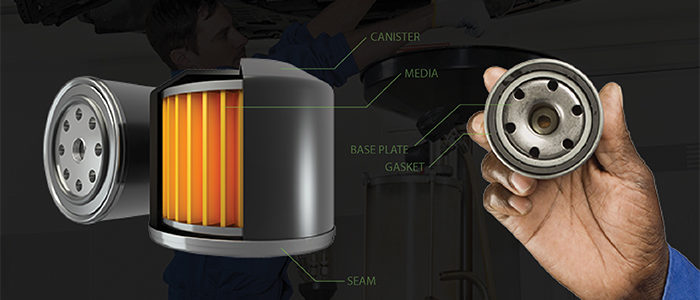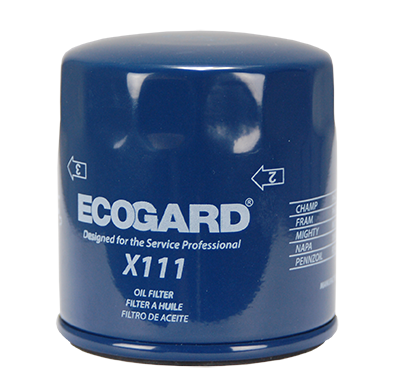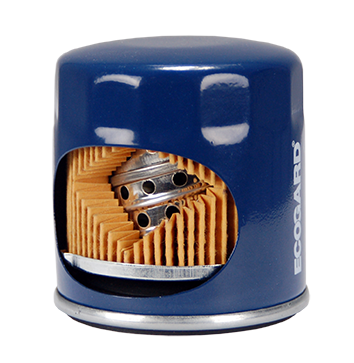
Key Characteristics of a Well-Made Oil Filter
Customers rely on professional installers for quality vehicle service and replacement parts, and spin-on oil filters are no exception. From the outside, most spin-on oil filters look similar. However, there are some significant differences in the quality of the internal components of a spin-on oil filter that can impact the ability of the filter to perform as well as the recommended replacement interval for the oil filter.
The visible components of a spin-on oil filter include the outer canister, base plate, and sealing gasket. Spin-on oil filters may feature varying numbers of flutes on the outer canister. These are designed to assist with installation and removal. Generally, the number of flutes is tied to the diameter of the canister. Spin-on oil filters may utilize an inboard seam or an outboard seam at the base of the filter depending upon the manufacturer’s design. The sealing gasket retained on the base plate of the filter may be a molded gasket or a lathe-cut gasket and may be made from a silicone material or nitrile material. Filters designed for an extended oil change service interval should be made from silicone material to ensure durability over the long term. Nitrile is a perfectly suited material for normal oil change intervals.

Graphical elements on the filter exterior may vary as well, with some filters offering helpful quadrant markings which are used as a guide by the installer to properly tighten the filter to the sealing surface on the engine. Oil filters have a shelf-life and are manufactured in batches so it’s also important for a spin-on oil filter to feature a date code that is clearly understandable and printed on the filter for any lot control measures needed in the field prior to installation. Other printing on the spin-on filter canister should include part number, industry cross references, installation instructions and bar-coding for proper identification of the filter.
Graphical elements on the filter exterior may vary as well, with some filters offering helpful quadrant markings which are used as a guide by the installer to properly tighten the filter to the sealing surface on the engine.

Oil filters have a shelf-life and are manufactured in batches so it’s also important for a spin-on oil filter to feature a date code that is clearly understandable and printed on the filter for any lot control measures needed in the field prior to installation. Other printing on the spin-on filter canister should include part number, industry cross references, installation instructions and bar-coding for proper identification of the filter.
Inside of the filter are the anti-drainback valve, filter media, center support tube, pressure relief valve (sometimes referred to as the “bypass” valve) and tension spring. The materials used to manufacture each of the components are key to the lifespan of a spin-on oil filter.
A well-made oil filter features a durable metal canister that houses the various components and makes it easy to install and remove. The thicker the canister is, the more pressure it is going to be able to withstand. The threaded base plate is where the filter attaches to the mounting surface of the engine. It is also where the oil enters and exits the filter. A thicker base plate allows for additional threading, which helps ensure that the filter will stay securely sealed on the engine while being subjected to pulsing engine oil pressure during normal operations. Heftier components translate to increased weight. So, In general, the more heft or weight to the canister, the better. With a well-made spin-on oil filter, you should literally be able to “feel” the filtration power in your hand. Because all filters must pass SAE (Society of Automotive Engineers) test requirements, the thickness, or gauge, of housings and base plates is most relevant for systems that run at uncommonly high oil pressures.
The anti-drainback valve feature prevents engine dry starts by retaining oil in the filter after the engine has been stopped. Anti-drainback valves can be produced using silicone material or nitrile material depending upon the design of the particular filter. Silicone anti-drainback valves are important for filters designed for applications with extended oil change intervals while nitrile is a suitable material for filters designed for normal oil change intervals.

The center support tube of a well-made spin-on oil filter should be manufactured from corrugated steel and formed as one piece through a winding process. This method provides the strength needed to prevent media collapse during high oil pressure operations and ensures a consistent flow of oil to the lubrication system of the engine.
Central to the functionality of a spin-on oil filter is the filter media. This is the material that does the actual filtration work. The three primary types of filter media include cellulose, synthetic and microglass.
The center support tube of a well-made spin-on oil filter should be manufactured from corrugated steel and formed as one piece through a winding process. This method provides the strength needed to prevent media collapse during high oil pressure operations and ensures a consistent flow of oil to the lubrication system of the engine.

Central to the functionality of a spin-on oil filter is the filter media. This is the material that does the actual filtration work. The three primary types of filter media include cellulose, synthetic and microglass.
- Cellulose-media filters contain paper media manufactured from wood pulp. Cellulose media has large fibers and on average such media will eliminate 97% – 98% of the contaminants from engine oil. An advantage of cellulose media is that it can also absorb some water contamination. Filers made with cellulose media are also the most economical and generally designed for normal oil change intervals.
- Synthetic-media filters contain media made from synthetic fibers. Such filters can trap smaller particles over a longer period of time than filters made with cellulose media which usually amounts to more miles between oil change intervals. These filters are produced with man-made glass fibers and remove 99% of small particles from the engine oil. Synthetic media offers more consistent porosity and smaller fiber size, which contributes to higher dirt-holding capacity, higher oil flow capacity and greater filter longevity.
- Microglass-media filters are produced with extremely fine glass fibers that are ten times thinner than cellulose fibers. These filters offer high oil flow capacity and can trap more than 99% of contaminants and extremely small particles.
The oil filter’s pressure relief valve (also known as a “bypass” valve) allows oil to sidestep the filter media if the media is clogged or if the oil being filtered is too cold to pass through the media at an adequate rate such as during a cold start-up. Some pressure relief valves are manufactured from plastic and may not be molded well enough to seal properly, which could lead to oil bypassing the filter media when it shouldn’t. The better option is a spring-loaded bypass valve made of steel, which is precision manufactured and more durable.
A well-made spin-on oil filter is made up of durable components that make it tough enough to stand up to anything that modern engines can throw at it while still offering exceptional filtering capacity and efficiency. All of these components come together to keep the engine oil clean and performing at its best. Whether you’re a professional installer, an enthusiast, or a weekend DIYer, having a well-made, reliable oil filter is of the utmost importance when maintaining an engine.
Tags: Conventional, Oil, Synthetic
Categories: Oil Filters, Spin-on Oil Filters, Synthetic Oil FiltersShare this entry